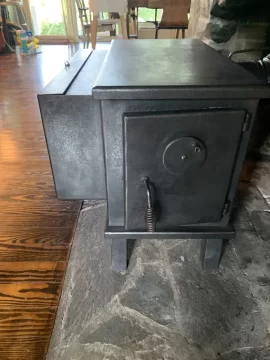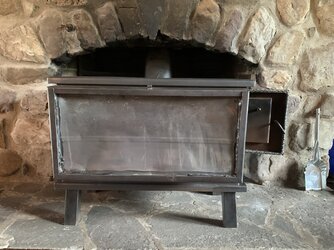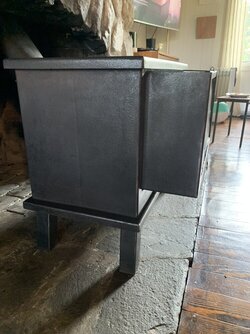Help to identify stove, please.
- Thread starter Camrwalk
- Start date
-
Active since 1995, Hearth.com is THE place on the internet for free information and advice about wood stoves, pellet stoves and other energy saving equipment.
We strive to provide opinions, articles, discussions and history related to Hearth Products and in a more general sense, energy issues.
We promote the EFFICIENT, RESPONSIBLE, CLEAN and SAFE use of all fuels, whether renewable or fossil.
You are using an out of date browser. It may not display this or other websites correctly.
You should upgrade or use an alternative browser.
You should upgrade or use an alternative browser.
Looks like it maybe an early Rohn or a copy of one you might get more help in the classic woodstove forum
Well thank you very much John.Looks like it maybe an early Rohn or a copy of one you might get more help in the classic woodstove forum
stoveliker
Minister of Fire
I presume there is no (UL) label on the back that tells you what this is?
That also means, I believe, that you need to have 3 ft of clearance to all sides. And that means that the front is not safe?
That also means, I believe, that you need to have 3 ft of clearance to all sides. And that means that the front is not safe?
Yes, the floor looks darkened in front of the stove. It's a side loader with may reduce front clearance, but the front overhang can be highly radiant. The floor needs insulated protection.
The stove looks like it may have had a ceramic glass window where someone broke it and replaced it with seamed sheetmetal then slathered in the front edges in an attempt to seal it. Time to retire this old relic. A modern stove will be safer, use much less wood, and will provide a nice fire view.
The stove looks like it may have had a ceramic glass window where someone broke it and replaced it with seamed sheetmetal then slathered in the front edges in an attempt to seal it. Time to retire this old relic. A modern stove will be safer, use much less wood, and will provide a nice fire view.
Thanks for your replies. I can say this fired up for the first time last night, for only 2 hours or so, the floor got warm. Not to say that it couldn’t be a problem for a prolonged period of time, of course. There is no darkening from the stove though. It is intended to extend the hearth to the front a couple of feet. Last night was a test run to make sure everything was running smoothly, after several test runs outdoors with the flue attached. With only four logs it bumped the house temperature up to 76 degrees (from 65) in those 2 hours last night. That satisfies my requirements at least, though I admit it was only a mildly cold evening last night. It radiates serious heat from the top, the back has fire bricks, the front overhang is protected internally by pikes, to stop the logs falling into it I suppose, and the front is nowhere near as hot as the top. Very cosy overall. hoping to use the top for some light cooking. The top is reinforced internally with a flanges. This was given to me, a new stove, this year at least, is out of my budget, not to mention most modern stoves don’t match my aesthetic preference the way this one does. I would very much like to replace the glass though, firstly because it is indeed lovely, and second it’s hard to gauge the fire currently. Any tips regarding that most welcome. It’s difficult, or perplexing to me, as there is a channel where the copper sheet (which is set in with high temp caulk currently) that is at the front which seems like it could be easily sealed with a gasket, but behind that is a 1 inch framed stop, the top of which is just open, and the L profile plate seemingly just sits on top. Attached a new picture. So not sure how to “seal” it all.Yes, the floor looks darkened in front of the stove. It's a side loader with may reduce front clearance, but the front overhang can be highly radiant. The floor needs insulated protection.
The stove looks like it may have had a ceramic glass window where someone broke it and replaced it with seamed sheetmetal then slathered in the front edges in an attempt to seal it. Time to retire this old relic. A modern stove will be safer, use much less wood, and will provide a nice fire view.
Thank you again
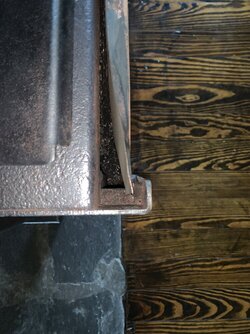
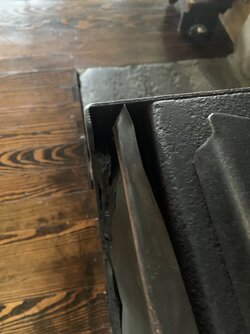
It may not leak smoke into the room especially with a good draft but it could allow air to draft into the stove may create an over fire situation with more wood or hotter fire. You could check this with incense sticks while the stove is burning. If you replace the glass make sure it is ceramic glass like Pyroceram for wood stoves.Thanks begreen. It certainly isn’t currently, though it doesn’t seem to leak any smoke. I’d like to order new glass and make it as tight as possible, but the opening as it’s made doesn’t make it easy to understand how. Anyway, thanks for the input.
stoveliker
Minister of Fire
In addition to the above, at the end of a burn, if it leaks, and if (when?) draft reverses when the chimney cools down, one might get the CO from the last glowing coals into the room.
I don't know if stoves of that era were ever meant to be completely air tight. The original stove I started burning was sort of a steel box with bifold glass doors on front. The glass was not really sealed/gasketed to the the door frame and the doors certainly weren't gasketed to the fire box. The main air control was by dialing back the damper. So it was sort of a prefab metal fireplace that had a nice black enamel outer shell.
Anyway, eyeballing these pictures, it almost seems like there is a U or C channel on three sides of that opening... with the top being generally open, except for a cover that is removable? Given you will be cleaning the glass A LOT, If I had to do it, I would weld up a metal frame to fit that channel snugly, but without binding. On the inside of my frame, I'd have a flange to hold the glass with a gasket and provisions to attach retainer strips. You'd basically be building something like a picture frame with a steel frame and ceramic/glass sheet in the center. The 'picture', is your fire, and you can lift the frame out the top for easy, and, did I mention frequent, cleaning.
Obviously this is going to require a modest amount of fabrication and metal working, so not sure you're really looking to go that route. There are also several key issues like you need to provide some allowance for steel expansion with heat while the glass/ceramic essentially has zero expansion. If you are looking to do all this, I could detail the design more.
Though overall, it seems like there might be a frame or other pieces missing. I don't know that this is going to be a "Buy a sheet of glass (ceramic) and a couple bolts." type repair.
At a bare minimum, I guess you could get a sheet of glass(ceramic) and stuff it in that channel with a bunch of gasket material all the way around. But it would need a new gasket each time you remove the glass. Though maybe someone recognizes that stove more closely and knows exactly what it does need.
Anyway, eyeballing these pictures, it almost seems like there is a U or C channel on three sides of that opening... with the top being generally open, except for a cover that is removable? Given you will be cleaning the glass A LOT, If I had to do it, I would weld up a metal frame to fit that channel snugly, but without binding. On the inside of my frame, I'd have a flange to hold the glass with a gasket and provisions to attach retainer strips. You'd basically be building something like a picture frame with a steel frame and ceramic/glass sheet in the center. The 'picture', is your fire, and you can lift the frame out the top for easy, and, did I mention frequent, cleaning.
Obviously this is going to require a modest amount of fabrication and metal working, so not sure you're really looking to go that route. There are also several key issues like you need to provide some allowance for steel expansion with heat while the glass/ceramic essentially has zero expansion. If you are looking to do all this, I could detail the design more.
Though overall, it seems like there might be a frame or other pieces missing. I don't know that this is going to be a "Buy a sheet of glass (ceramic) and a couple bolts." type repair.
At a bare minimum, I guess you could get a sheet of glass(ceramic) and stuff it in that channel with a bunch of gasket material all the way around. But it would need a new gasket each time you remove the glass. Though maybe someone recognizes that stove more closely and knows exactly what it does need.
ridemgis
Feeling the Heat
Wonderful Corey, thank you. I may do the cheap and dirty “stuffing” of gasket in front channel against glass, and figure something temporary with that loose piece that still makes a good seal somehow. But all good ideas. For now at least, I think I might come back to you though if it’s proving to be a worthy stove to keep long term .
Ridemgis! That’s it! Or similar enough that now I’ve found the exact one in various forum topics here and Google images. I will continue to scour the internet hoping to find some better close ups or a diagram even perhaps. It is a great stove and used to have a bifold style door on the inside which could be closed and opened if you were to leave the stove unattended. Apparently it was only tempered glass back then.
Thanks to you both. Great!
Ridemgis! That’s it! Or similar enough that now I’ve found the exact one in various forum topics here and Google images. I will continue to scour the internet hoping to find some better close ups or a diagram even perhaps. It is a great stove and used to have a bifold style door on the inside which could be closed and opened if you were to leave the stove unattended. Apparently it was only tempered glass back then.
Thanks to you both. Great!
glass might have been taken out for a good reason. maybe the door is warped and it is getting to hot with one part of the glass mount expanding more than the other and crack. i wouldn't trust a stove that the only way to turn the heat down is a pipe damper.
The glass broke, I suspect, because in 1978 they didn’t yet have ceramic glass. It was tempered. Glass can break for many reasons, including accidentally by some kind of impact. The glass is fixed in the outer channel with no noticeable signs of warping. Additionally there is a pipe damper and a rotating vent control on the door itself, which is solid and on the side of the stove btw. Thanks for your concerns though, I guess….
If you could be more specific about your comment regarding copper it might be more helpful. Thanks
If you could be more specific about your comment regarding copper it might be more helpful. Thanks
Yep - looks like a winner with the Russo. Guess you've seen, but they are still in business - so they might be able to offer technical assistance - possibly even replacement parts:
We throw around the term 'glass' or 'stove glass' but as you mention, we really mean ceramic as in pyroceram, neoceram or robax. While these new ceramics can certainly take more heat than tempered glass, two key things to remember: The main reason they take the heat is that they have essentially zero thermal expansion. So hot and cold does not really 'shock' or stress the glass. But also means you need to account for thermal expansion of the steel stove when you fit your window pane. Also, I haven't noticed the ceramics to be notably more impact resistant than tempered glass. So definitely be careful with logs either way. I've broken at least two panes over the decades. I now take extra care to only put round logs in the back / bottom of the stack!
Russo Products, Inc. - View Our Online Catalog - Randolph, MA
Providing Quality Products for the Fireplace Industry for Over 40 Years. Gas, Wood, Pellet, Electric & Other Products - Including Russo Stove Parts.
www.russoproducts.com
We throw around the term 'glass' or 'stove glass' but as you mention, we really mean ceramic as in pyroceram, neoceram or robax. While these new ceramics can certainly take more heat than tempered glass, two key things to remember: The main reason they take the heat is that they have essentially zero thermal expansion. So hot and cold does not really 'shock' or stress the glass. But also means you need to account for thermal expansion of the steel stove when you fit your window pane. Also, I haven't noticed the ceramics to be notably more impact resistant than tempered glass. So definitely be careful with logs either way. I've broken at least two panes over the decades. I now take extra care to only put round logs in the back / bottom of the stack!
Try local big glass shops and ask if they cut and sell pyroceram, robax, or neoceram ceramic glass. If none, these folks offer good service.
www.onedayglass.com
www.onedayglass.com
ridemgis
Feeling the Heat
Don't try this at home kids - Kuma Wood Stove video on stove "glass" durability.Yep - looks like a winner with the Russo. Guess you've seen, but they are still in business - so they might be able to offer technical assistance - possibly even replacement parts:
Russo Products, Inc. - View Our Online Catalog - Randolph, MA
Providing Quality Products for the Fireplace Industry for Over 40 Years. Gas, Wood, Pellet, Electric & Other Products - Including Russo Stove Parts.www.russoproducts.com
We throw around the term 'glass' or 'stove glass' but as you mention, we really mean ceramic as in pyroceram, neoceram or robax. While these new ceramics can certainly take more heat than tempered glass, two key things to remember: The main reason they take the heat is that they have essentially zero thermal expansion. So hot and cold does not really 'shock' or stress the glass. But also means you need to account for thermal expansion of the steel stove when you fit your window pane. Also, I haven't noticed the ceramics to be notably more impact resistant than tempered glass. So definitely be careful with logs either way. I've broken at least two panes over the decades. I now take extra care to only put round logs in the back / bottom of the stack!
copper is a soft and very expensive metal so soft that it will try and curl under heat. if it is a thick piece of copper then the guy that put it in spent way more money than a piece of ceramic glass of what the guy did that owned my h2 before me was put in two sheets of glass. and that is what could be that it is eating wood and you are not getting much time out of a load
Similar, but there are details missing. Maybe an earlier model?Russo?
Russo Wood Stove 3GVR Manual
Hello everyone. I recently moved into a house with a wood stove, so I'm looking for some information about it. According to the data plate, it is from the Russo Wood Stove Mfg. Corp, model 3GVR High Heat, date tested 9/7/78, fuel approved Wood. I have had it inspected and cleaned, along with...
 www.hearth.com
www.hearth.com
Similar, but there are details missing. Maybe an earlier model?
Russo Wood Stove 3GVR Manual
Hello everyone. I recently moved into a house with a wood stove, so I'm looking for some information about it. According to the data plate, it is from the Russo Wood Stove Mfg. Corp, model 3GVR High Heat, date tested 9/7/78, fuel approved Wood. I have had it inspected and cleaned, along with...www.hearth.com
I thinks it’s the front glass view 2gvr
Similar threads
- Replies
- 2
- Views
- 534
- Replies
- 7
- Views
- 570
- Replies
- 8
- Views
- 511
- Replies
- 4
- Views
- 1K


